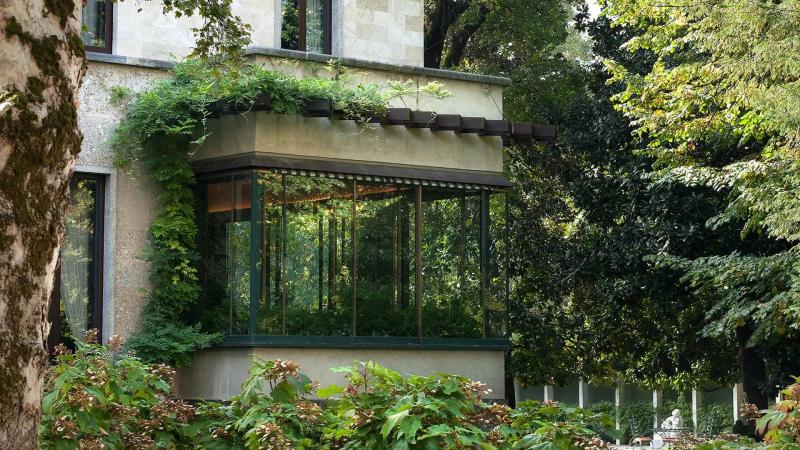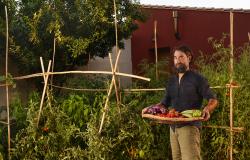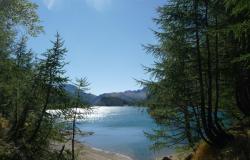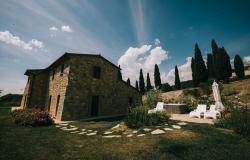Emanuela Borio spends her days in the gardens of the past, among the artistic topiaries, observing colorful beds of perennials, and in the shade of 16th century villas, Roman temples and medieval castles. An agronomist by trade, she is responsible for the parks and gardens of the Fondo per l’Ambiente Italiano — Italian National Trust — curating around a dozen sites in northern Italy.
Created on example of the British National Trust, the Italian Trust, or FAI as it’s known colloquially, owns more than 60 donated sites of cultural and historical significance throughout Italy, from noble palaces and castles to a biogenetic reserve of giant black pines in Calabria and a Carlo Scarpa-designed tomb in Veneto. FAI restores the sites to their historical state and maintains them as open to the public, “so everyone can experience them.”
In her acre-and-a-half home garden in the province of Varese on a warm spring day, Emanuela talks about her work for FAI. Her garden is lush — here, we are in the lakes region of northern Italy, a densely vegetated area with a “typically” mild and rainy climate still weathering fairly well the extreme conditions of recent years — largely left to its own devices compared to the more curated plots of historical gardens she curates for FAI.
The early evening sky is a silky blue with cotton-candy clouds breezing past the Alps on the horizon. Emanuela lounges in a creaky chair under the lime-green leaves of a freshly budded maple rooted at the base of the 16th century villa, her long flowy skirt draped to her ankles, colorful earrings studding silver hair. Between interruptions from her three squirming grandkids, the chirping of her crickets’ ringtone and neighbors popping in, she discusses the beauty of the historical sites she manages and the challenges of curating historical gardens when the climate is no longer what it was when they were designed in the 16th, 17th, or even 20th centuries.
This interview has been edited for length and clarity.
Emanuela Borio on “bringing May flowers” and more

Alexa Ahern: Nearly all of the FAI sites are open to the public with an entrance fee. Why do you think it is important for the gardens of FAI historical sites to be accessible to the public?
Emanuela Borio: The purpose is to share a sense of quality of life that you don’t always find in public properties or in cities. That is, quality of restoration of a historical building or garden. Before, there were princes, now there are citizens, and they must be treated in the same way, to enjoy the beauty and care just as the princes used to.
AA: Most of the FAI properties need restoring before they can be visited by the public. What does restoring a historical garden involve, exactly?
EB: When I first receive a site, it has already been restored. There are hedges. Rhododendron bushes. The trees are trimmed. The first task is to reintroduce flowers. You need flowers.
AA: Are there rules you must follow for what can and cannot be introduced in a historical garden?
EB: There’s this dichotomy: you have the environmental part, for which everything must be organic. Due to EU regulations, we are not allowed to use any more pesticides or other [non-organic] products. And then there’s the historical part. For example, there’s the boxwood shrub, which must be kept because it is a historical structure, so changing the species in Italy is a cultural issue. The boxwood dates back to the Roman era.
AA: So, what’s the problem with maintaining certain historical plants today?
EB: At the same time as when the law on organic products was introduced, you had globalization; so many exotic and also invasive plants, as well as insects, were arriving. The boxwood shrub was destroyed. A shaped boxwood is a historical structure and part of the design of a historical garden and must be maintained. They are architecture, like statues, but they have to be healthy. I don’t have 50 gardeners who go check on them every day. There are a couple gardens where they go at night to squish all the caterpillars by hand, but that’s just not possible.
AA: How has this changed your job?
EB: I have to always be aware of the organic movement. I must know what antagonistic insects there are and antagonistic mushrooms, and how to improve the soil so the good mushrooms grow. For the past four years, I have also focused on areas of the gardens that need to be redone, so I asked myself what plants I can use. What solutions would provide flowers because a garden from the 18th century needs flowers, but they also must be low-maintenance and need little water. We’ve used some microirrigation systems, but today it’s no longer enough because the wells have run dry. Last year was the first year in this area that almost all the wells were dry.
AA: Do the restrictions on what you can plant mean there is less variety in the gardens?
EB: Not necessarily. For example, at Villa Panza [in Varese], there is a flowerbed that is 100 meters long that had basic roses. They were awful, and the soil was barren. I changed it to a mix of herbaceous perennials, working mostly with Mediterranean plants because it’s so much hotter now. It turned out wonderfully. So, the type of plant you can insert changes.
AA: What are some of the plants that are suffering from the drier and hotter climate?
EB: The rhododendrons, which are from the lakes region, suffer a lot. The exotic plants from the 18th and 19th centuries, like the thuja, sequoia and cryptomeria. At Villa Panza, there is a sequoia that is two-thirds dry. The question is, with what do you replace this type of plant, which is associated with the collections of exotic plants from the mid-18th and 19th centuries? It’s a big question mark because we have not quite entered a Mediterranean climate yet here. It’s a difficult phase.
AA: Speaking of shifting climates, you also worked on the Vertical Forest in Milan. What was that experience like?
EB: Stefano Boeri asked me to help him figure out how to make it work. The exciting thing was that the forest wasn’t supposed to be a series of gardens. A forest is an organism and must be approached as such. The four sides were designed separately based on temperature, light, and wind. The principle behind it is very intelligent because there are so many people living in cities. How much does a piece of land in the city cost? If we can think about a vertical surface or roof as a biological skin, it’s obvious that the temperature and biodiversity will change.
AA: Are there any other FAI gardens you would recommend visiting to anyone traveling in Italy?
EB: I quite like the garden of Villa della Porta Bozzola, which is off the tourist track and a beautiful 18th-century garden in the middle of the forest near Lake Maggiore. The Villa Gregoriana park is also beautiful. It’s a gorge outside Tivoli, near Rome, where waterfalls disappear into the rocks, a very wild landscape. A classic one is Villa Balbianello. It’s a more recent garden, from the early 20th century. It’s full of topiaries but nothing extravagant. And Lake Como in the background makes it truly extraordinary. Then I’d say the Garden of Kolymbethra, an orange grove in Sicily, near Agrigento, which was an incredible project to restore an ancient plumbing system that still works today to supply a citrus grove.



















